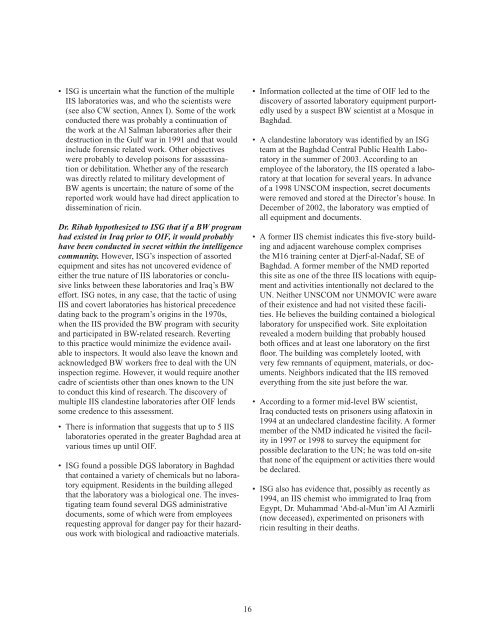Comprehensive Report
GPO-DUELFERREPORT-3
GPO-DUELFERREPORT-3
- No tags were found...
Create successful ePaper yourself
Turn your PDF publications into a flip-book with our unique Google optimized e-Paper software.
• ISG is uncertain what the function of the multiple<br />
IIS laboratories was, and who the scientists were<br />
(see also CW section, Annex I). Some of the work<br />
conducted there was probably a continuation of<br />
the work at the Al Salman laboratories after their<br />
destruction in the Gulf war in 1991 and that would<br />
include forensic related work. Other objectives<br />
were probably to develop poisons for assassination<br />
or debilitation. Whether any of the research<br />
was directly related to military development of<br />
BW agents is uncertain; the nature of some of the<br />
reported work would have had direct application to<br />
dissemination of ricin.<br />
Dr. Rihab hypothesized to ISG that if a BW program<br />
had existed in Iraq prior to OIF, it would probably<br />
have been conducted in secret within the intelligence<br />
community. However, ISG’s inspection of assorted<br />
equipment and sites has not uncovered evidence of<br />
either the true nature of IIS laboratories or conclusive<br />
links between these laboratories and Iraq’s BW<br />
effort. ISG notes, in any case, that the tactic of using<br />
IIS and covert laboratories has historical precedence<br />
dating back to the program’s origins in the 1970s,<br />
when the IIS provided the BW program with security<br />
and participated in BW-related research. Reverting<br />
to this practice would minimize the evidence available<br />
to inspectors. It would also leave the known and<br />
acknowledged BW workers free to deal with the UN<br />
inspection regime. However, it would require another<br />
cadre of scientists other than ones known to the UN<br />
to conduct this kind of research. The discovery of<br />
multiple IIS clandestine laboratories after OIF lends<br />
some credence to this assessment.<br />
• There is information that suggests that up to 5 IIS<br />
laboratories operated in the greater Baghdad area at<br />
various times up until OIF.<br />
• ISG found a possible DGS laboratory in Baghdad<br />
that contained a variety of chemicals but no laboratory<br />
equipment. Residents in the building alleged<br />
that the laboratory was a biological one. The investigating<br />
team found several DGS administrative<br />
documents, some of which were from employees<br />
requesting approval for danger pay for their hazardous<br />
work with biological and radioactive materials.<br />
• Information collected at the time of OIF led to the<br />
discovery of assorted laboratory equipment purportedly<br />
used by a suspect BW scientist at a Mosque in<br />
Baghdad.<br />
• A clandestine laboratory was identified by an ISG<br />
team at the Baghdad Central Public Health Laboratory<br />
in the summer of 2003. According to an<br />
employee of the laboratory, the IIS operated a laboratory<br />
at that location for several years. In advance<br />
of a 1998 UNSCOM inspection, secret documents<br />
were removed and stored at the Director’s house. In<br />
December of 2002, the laboratory was emptied of<br />
all equipment and documents.<br />
• A former IIS chemist indicates this five-story building<br />
and adjacent warehouse complex comprises<br />
the M16 training center at Djerf-al-Nadaf, SE of<br />
Baghdad. A former member of the NMD reported<br />
this site as one of the three IIS locations with equipment<br />
and activities intentionally not declared to the<br />
UN. Neither UNSCOM nor UNMOVIC were aware<br />
of their existence and had not visited these facilities.<br />
He believes the building contained a biological<br />
laboratory for unspecified work. Site exploitation<br />
revealed a modern building that probably housed<br />
both offices and at least one laboratory on the first<br />
floor. The building was completely looted, with<br />
very few remnants of equipment, materials, or documents.<br />
Neighbors indicated that the IIS removed<br />
everything from the site just before the war.<br />
• According to a former mid-level BW scientist,<br />
Iraq conducted tests on prisoners using aflatoxin in<br />
1994 at an undeclared clandestine facility. A former<br />
member of the NMD indicated he visited the facility<br />
in 1997 or 1998 to survey the equipment for<br />
possible declaration to the UN; he was told on-site<br />
that none of the equipment or activities there would<br />
be declared.<br />
• ISG also has evidence that, possibly as recently as<br />
1994, an IIS chemist who immigrated to Iraq from<br />
Egypt, Dr. Muhammad ‘Abd-al-Mun’im Al Azmirli<br />
(now deceased), experimented on prisoners with<br />
ricin resulting in their deaths.<br />
16


